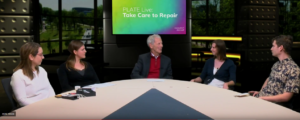Last week, Materialising Memories team member Annemarie Zijlema (me) participated in the Disruptive Innovation Festival. She took part in the panel discussion ‘Take Care to Repair’ with moderator Walter Stahel (founder-director of the Product-Life Institute in Geneva). The panel discussed the question how we get people to take care and repair their products, to increase the longevity of products to achieve sustainability. Annemarie talked about why some products are preserved, while others are discarded, from a memory perspective (starting at app. 24:48 minutes). The discussion was broadcasted live, and can be viewed back till 9 December 2017 via the following link:
https://www.thinkdif.co/sessions/the-plate-conference-presents-take-care-to-repair
The session was initiated by and recorded during the PLATE conference (Product Lifetimes and the Environment) at TU Delft. Annemarie presented her paper on ‘preserving objects, preserving memories’ on the role of traces on objects and repair on remembering. The proceedings are published open access on the PLATE website: http://www.plateconference.org/second-plate-conference/programme/.
